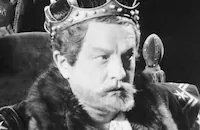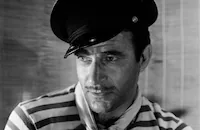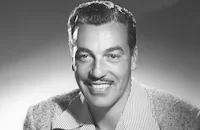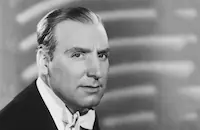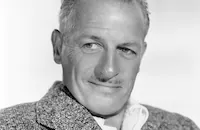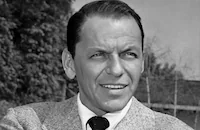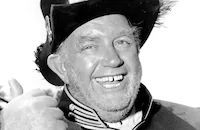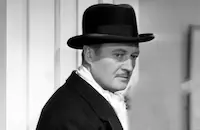Notes
[Note: Extensive crew and cast credits in the above record, and the note below, are principally derived from the film's Almanac, titled Michael Todd's Around the World in 80 Days Almanac: The Story of the World's Most Honored Show, which was sold at road show engagements. Although hundreds of extras were listed in the Almanac, space limitations do not allow inclusion of all their credits here.]
Around the World in Eighty Days opens, without credits, on a prologue featuring Edward R. Murrow. Murrow is seated behind a desk in a contemporary office setting and discusses the "fantastic fiction" of Jules Verne, including the novel From the Earth to the Moon, which was the basis for the 1902 Georges Méliès silent film Voyage dans la lune (A Trip to the Moon). Méliès' film is then projected as Murrow brieflya narrates. [Note: The Méliès film, which was also based on a book by H. G. Wells, is not shown in its complete version. For further information, consult the entry for the film in the AFI Catalog. Film Beginnings 1893-1910.] As the picture concludes, Murrow observes that "Jules Verne's rocket returns to the earth, a minor planet, where fiction lags behind fact."
The film then shifts to contemporary footage of a guided missile test-launch in New Mexico. According to the Hollywood Reporter review, the film "opens up" to 28 x 56 feet for this footage, which is followed by color images of the earth seen from space, as shot by a camera mounted on the missile. The Hollywood Reporter review added that this footage was "[n]ever-before-seen." As the rocket reaches outer space, Murrow continues his narration: "You are now looking at the receding shape of this planet earth. This is how the earth looks from a camera in the rocket. Jules Verne wrote a book about going around the world in eighty days. He even predicted it could be done in eighty hours. Today, it can be done in less than half that time....There was a time not so long ago when learned men thought [the earth] was flat. Around the World in Eighty Days is the Jules Verne classic, and the world was already shrinking when it was written, and that was in 1872." The main story then opens on a scene in London, England, in 1872.
The film closes with a scene at the Reform Club, when Robert Morley's character announces that "it is the end," in a double entendre meaning the end of the British empire because a woman is inside the club, and the end of the film. Credits immediately follow, and are introduced by a header reading "Who was seen in what scene...and who did what." The credits roll begins with cast credits, which later are interspersed with crew credits after Shirley MacLaine's name is listed; no character names are listed onscreen. The job descriptions for the crew are all in lowercase letters. The animated color credits, which were created by Saul Bass, feature caricatures and artwork of the performers and crew, and suggest the scenes in which the actors appeared. An old-fashioned bicycle represents "Passepartout," a pocketwatch with legs represents "Phileas Fogg" and "Princess Aouda" is represented by an impressionistic face with green eyes and flowing scarves. These three icons are seen throughout the credits, sometimes followed by a mustachioed face that represents "Inspector Fix."
In addition, the music also changes to match the scenes. The cast credit for Jose Greco reads "Jose Greco and Troupe"; individual members of Greco's troupe listed in the above cast credits were derived from the Almanac. The credits for technical consultant Edward Williams and Kevin O'Donovan McClory fall under the heading "Foreign Locations." McClory's credit reads "second unit director and assistant to the producer." In the final credits sequence, various production credits appear with numerous figures depicted behind prison bars. Michael Todd's producing credit then appears, accompanied by a figure of a warden unlocking the bars and freeing the prisoners. An angel holding a book hovers overhead alongside the credit for Jules Verne; the book then drops on the head of the warden, who falls off the bottom of the screen. At the end, the Fogg clock icon enlarges and opens like a pocketwatch. The title credit is on the left side of the watch; on the right is the watch's internal mechanism, which pops apart to reveal a beating heart. The film's title is the last credit. Although most contemporary sources, including the Almanac, list the title as Around the World in 80 Days, in the end credits, Eighty is spelled out.
Around the World in Eighty Days marked Todd's first solo effort as a film producer. It was shot extensively on location in many of the locales depicted, and used hundreds of crew and extras. According to modern sources, Todd was looking for the right property to feature his newly invented Todd-AO photographic process, which made its debut in the 1955 Rodgers and Hammerstein film Oklahoma! . Around the World in Eighty Days was born at the suggestion of British producer Alexander Korda, who had purchased film rights to the 1946 Cole Porter-scored musical play based on the Verne book, produced on stage by Orson Welles. Unknown to Korda, Todd had invested in Welles's theatrical production but, according to the Almanac, withdrew from the play due to dissatisfaction with the script. Todd later bought the film rights from Korda for $130,000, according to a September 24, 1954 Hollywood Reporter news item. The news item also reported that Todd intended to begin filming on January 16, 1955 at Shepperton Studios in London.
Although the exact start date has not been determined, contemporary sources indicate that filming did not begin until August 1955, in Chinchón, Spain. News items also report that U.S. filming began in September 1955. A January 14, 1955 Hollywood Reporter news item reported that William Goetz was considering co-producing the film with Todd for a Columbia Pictures release, but neither Goetz nor Columbia were involved in the final production. A modern source adds that Columbia had initially agreed to fund 75% of the production, but withdrew their support before filming began. Modern sources also add that in 1956, Todd screened an incomplete version of the film for Columbia executives who were considering distributing the film, but pulled out because he believed that Columbia production head Harry Cohn would demand the right to make creative decisions.
According to Hollywood Reporter production charts, John Farrow was initially slated to direct the film. According to modern sources, Todd was dissatisfied with Farrow's work and fired him after only two days of filming bullfight scenes in Chinchón. Todd mentioned the incident in Hollywood Reporter on March 15, 1957 in his "The Seams of the Dresses" advertising campaign (see below), referring to it as "a quick change of personnel" that "necessitated my moving in," and noting that he directed the Spanish sequences himself. He then hired Michael Anderson to shoot the British sequences of the picture, intending to have a separate American director for the U.S. scenes. Todd instead retained Anderson for the entire film. It is possible that the Chinchón footage was used only as background, as a later Hollywood Reporter news item dated August 8, 1956 reported that Cantinflas was filmed killing three bulls before a live audience at the Plaza Mexico bullring in Mexico City. Emmett Emerson, who was listed in early Hollywood Reporter production charts as Farrow's assistant director, was not credited onscreen or in the Almanac. When Anderson replaced Farrow, Emerson's name was replaced by that of Ivan Volkman in Hollywood Reporter production charts. Emerson's contribution to the final film has not been confirmed.
A October 24, 1955 Hollywood Reporter news item listed several dancers appearing in the Bombay temple sequence. Several of these dancers were credited in the Almanac only as extras, except for Babs Christie, whose name does not appear in the Almanac. Her appearance in the final film has not been confirmed. Various Hollywood Reporter news items also include Joe Mayer, Betty Marikawa, Joan Marikawa and Satini in the cast. None of these names appear in the Almanac, and their appearance in the film has not been confirmed. However, a news item dated November 16, 1955 reported that Satini was a fire-eater; he May appear in a background scene. Modern sources add that Todd initially cast Gregory Peck in a cameo, but recast the role with Col. Tim McCoy, and that Todd had sought John Wayne for a part in the film, but was turned down. Modern sources also note that Todd hired Maurice Chevalier for the French sequence, but replaced him with Fernandel because of a dispute over billing. Actresses considered for the role of Princess Aouda, according to modern sources, included Jacqueline Park, Suzanne Alexander and Marla English.
A October 27, 1955 Hollywood Reporter news item noted that when Todd purchased the rights to Cole Porter's music score for Orson Welles's 1946 musical adaptation of Around the World in Eighty Days, he hired conductor Hugo Winterhalter as music director for his film. However, neither contributed to the motion picture production. According to an March 11, 1957 Hollywood Reporter advertisement written by Todd, Paul Weatherwax was the primary film editor during production, and completed the first rough cut. As there were no facilities with which to view the 65mm dailies during location filming, Weatherwax, who was working in Hollywood, was often the first to see the footage. However, Weatherwax left the production, after which Todd borrowed editor Gene Ruggiero from M-G-M.
The film was shot over a total of 160 days, although Hollywood Reporter production chart listings report only 89 days. Production statistics reported in the Almanac are as follows (except where noted): Costumes were rented from Western Costume Company in Los Angeles, and Berman Ltd. in London, as well as all the major studios. Todd procured assistance from governments in several countries, including King Phumiphon of Thailand, who loaned a royal barge and provided members of the Royal Thailand Navy to appear as oarsmen; the Emir of Falaika in then-Persia, who arranged for the use of local boats and citizens to row them; and the Nawab of Pritim Pasha in Pakistan, who loaned a herd of elephants and their herdsmen. In addition, residents of Chinchón, and local Native American tribes, including Cheyenne, Apache and Ute, appear in the film.
According to an article in International Photographer, the hot-air balloon named "La Coquette" was rented from the Balloon Club of America. Scenes with the balloon were filmed in France, Spain and Nevada. The balloon sequence was an invention of Todd and the screenwriters, and did not appear in Verne's novel. Although the sequence of the return to England by the steamship Henrietta was originally shot at a studio using miniatures, at a cost of $75,000, 1956 Hollywood Reporter news items dated 15 February and 16 February reported that Todd was re-shooting the sequence using a full-scale ship and live actors. The re-shoot was budgeted at $350,000, and was filmed offshore of Newport Beach, CA. According to Hollywood Reporter, Todd invited members of the press to witness the event. Modern sources add that the ship was purchased from the Scripps Institute, and was remodeled for the production.
Among the major locations cited in the Almanac, reviews and contemporary news items include Paris (France), Chinchón (Spain), Bangkok (Thailand) and Calcutta (India). Other sources add New Mexico and Durango, CO as additional locations. As reported in contemporary sources, including the Almanac, shooting on location was often problematic. In particular, the production company encountered several problems in Paris. In one instance, 2d unit director McClory had numerous cars towed away in order to allow for filming. Modern sources add that the filmmakers also pried open car windows and pushed cars out of the way. This act enraged local officials, who attempted to arrest Todd, but he had already departed with the footage. The next day, Parisian officials refused to honor location permits to all film productions, including the United Artists film Trapeze (see below). Modern sources report that Todd directed filming of animal scenes in New Mexico, which were to appear in the Western portion of the film. The total footage shot for Around the World in Eighty Days was reported as approximately 350,000 feet in a Hollywood Reporter advertisement. The Almanac noted that footage was also shot for a documentary about the making of the film, however, the documentary was never made. Other abandoned footage included two songs by Eddie Fisher, according to a modern source.
In August 1956, Todd became embroiled in a public debate about potential Communist influences on the production of Around the World in Eighty Days. According to a August 22, 1956 Hollywood Reporter news item, Todd had hosted a luncheon for Vladimir Surin, then a Russian minister of culture, at which Todd announced that he was in pre-production on a film to be shot in Russia. The next day, Hollywood Reporter columnist Mike Connolly reported that for Around the World in Eighty Days, Todd hired musicians who had been recently fired by Universal-International for refusing to testify before the House Committee on Un-American Activities (HUAC). Connolly mentioned by name two musicians, Eudice Shapiro and Victor Gottlieb, both of whom are credited offscreen in the Around the World in Eighty Days Almanac. Connolly posed the question as to whether there was "any connection" to Todd's involvement with Russia and the alleged-Communist musicians. Coincidentally, a news item in the same issue of Hollywood Reporter reported that musician Manuel Compinsky, another employee fired by Universal, had filed a lawsuit against the film company because of his dismissal. Compinsky is also credited in the Almanac for Around the World in Eighty Days.
Todd responded to Connolly's charge with a full-page advertisement in the August 25, 1956 issue of Hollywood Reporter in which he refuted Connolly's conjecture. Several days later, producer Stephen C. Apostolof, of SCA Film Productions, entered the fray by posting his own full-page statement in which he urged Todd to abandon the proposed production in the Soviet Union, positing that "freedom does not exist in Russia." Todd never produced a film in the Soviet Union.
According to numerous Hollywood Reporter news items, in September 1956, prior to the film's release, screenwriter James Poe filed a grievance with the Writers Guild of America (WGA) because his name was left out of the screen credits for Around the World in Eighty Days. At that time, only S. J. Perelman was credited onscreen for the script. Although the WGA determined that Perelman should share screenplay credit with Poe and discharged director John Farrow, Todd initially refused to add their names. Contemporary reviews such as Hollywood Reporter and Variety list only Perelman's name, although Variety acknowledged Poe and Farrow in the review's text. Todd reportedly protested the WGA's findings in a telegram, in which he insisted that not only did Poe not make significant contributions to the screenplay, but that he himself was declining screenplay credit despite having contributed to the script. Todd also asserted that he was not subject to the WGA's rulings as he had no contractual arrangement with the Guild.
The dispute continued through October 1956, when Todd's name was placed on the WGA's official list of "unfair producers." Todd then filed suit in a Santa Monica, CA, court against his bookkeeper, Bernard Reiss, and Poe, alleging that Reiss overpaid Poe, whose claims were fraudulent. Poe responded by threatening to obtain restraining orders against the exhibition of Around the World in Eighty Days, and also filed suit against Todd and his company in a New York court. Although the specific outcomes of the lawsuits have not been determined, the viewed print only credits Poe, Farrow and Perelman with the screenplay. A modern source adds that Todd and Perelman wrote impromptu scenes for cameos featuring John Mills, Beatrice Lillie, Hermione Gingold and Glynis Johns while they were shooting in London.
Around the World in Eighty Days opened in New York on October 17, 1956, at a theater that had been remodeled to accommodate the larger screens and sound systems for Todd-AO. Higher ticket prices accompanied the 70mm screenings and the road show exhibitions. The film was also released in 35mm prints and CinemaScope. Reviews noted an approximate running time of 175 minutes, with additional ten-minute intermissions. According to a October 22, 1956 Hollywood Reporter news item, Todd returned to Los Angeles after the New York premiere and cut three to four minutes from the footage prior to its Los Angeles release. In a modern interview, Mike Todd, Jr. reported that the total edit comprised six minutes, and included portions of the Western scenes. For the London opening, according to the modern interview with Todd, Jr., his father reduced the 65mm negative to 34mm to bypass British taxes that would have been assessed on the 70mm print.
December 1956 Hollywood Reporter news items added that Todd also re-dubbed Around the World in Eighty Days prior to the Los Angeles premiere. Todd hired the M-G-M sound department to complete the work. As reported in Hollywood Reporter news items, the Motion Picture Sound Editors Guild (MPSE) nominated the film for best sound editing of 1956. Not long after, however, the Motion Picture Film Editors Guild questioned both the film editing, sound editing and sound recording screen credits because they did not list the M-G-M crew, which included William Steinkamp, Robert Shirley and Robert Stirling. As reported in Hollywood Reporter on December 19, 1956, Todd stated that he switched to the M-G-M crew because of his ongoing dispute with the Todd-AO Corp., which was affiliated with Kling Studio, for which the original sound crew members worked. The names of the M-G-M crew did not appear in the credits of the viewed print.
In March 1957, prior to the Academy Awards ceremony, Todd launched a month-long advertising campaign in trade magazines such as Hollywood Reporter, which featured editorial-style sidebars with anecdotes, credits and other information about the production, written by Todd. Todd titled one of the series of advertisements "The Seams of the Dresses," so-named after an anecdote illustrating the copious detail involved in producing the film. In the first of this series, he wrote that he hoped to "give proper credit to a lot of people, well known and not so well known," who made the film possible, and noted that 68,894 people were involved in the production. The other series was titled "Around the Cracker Barrel," and often ran in the same issue. Much of the information in the advertisements is found in the Almanac.
The Almanac sold at roadshow exhibitions appeared in three editions. Published as a hardbound book, the Almanac contained twelve sections, including a foreword by Todd, production and cast biographies, and six pages listing the full cast and crew. According to November and December 1956 Hollywood Reporter news items, the Almanac was sold in bookstores as well as theaters, and 100,000 copies were published for the second printing. In the book, the featured performers were described as having "cameo" roles. Todd adopted the word "cameo" to mean a brief, featured performance by a prominent actor in a film. Todd is quoted as saying that "[t]here have been many other pictures loaded with big names but the story has always been built around the stars. My idea was to have each star fit the part in the story." The Hollywood Reporter review noted that "'Cameo' Bits Stand Out," and reported that "All of these featured performers play so-called `Cameo' bits, but each has a moment in which to register the flavor of an unusual and interesting personality on the screen. Running into them, old friends to many in the audience, is one of the many delights of this production." The term `cameo' and the practice of featuring prominent actors in small, often uncharacteristic roles later became common to the film industry.
Around the World in Eighty Days won the 1956 Academy Award for Best Motion Picture, Best Writing (Screenplay-Adapted), Best Cinematography (Color), Best Film Editing and Best Music (Music Score of a Dramatic or Comedy Picture), and was nominated for Best Directing, Best Art Direction (Color) and Best Costume Design (Color). Other awards include the following: Outstanding Directorial Achievement (Screen Directors Guild), Best Written Comedy (Screen Writers Branch of Writers Guild of America), Best All-Around Film (Foreign Language Press Film Critics Circle). In addition, the New York Film Critics, which added a screenwriting award in 1956, honored Around the World in Eighty Days with their first Best Screenplay award. The film was the top ranking film in the National Board of Reviews list of Best Pictures of 1956. Todd was also given a Jules Verne Medallion by The Jules Verne Society International.
Around the World in Eighty Days marked writer/actor Noël Coward's first American screen appearance since the 1935 Paramount film The Scoundrel (see AFI Catalog of Feature Films, 1931-40). In addition, Around the World in Eighty Days marked the American screen debut of Mexican movie star Cantinflas, as well as the feature film debut of bullfighter Luis Miguel Domingúin. According to the Almanac, Domingúin had been retired prior to appearing in the film.
On October 17, 1957, one year after the release of Around the World in Eighty Days, Todd held an "anniversary" party at Madison Square Garden. As noted in an article in New York Times, the event was paid for by CBS Television, which aired the live party in a ninety-minute national television broadcast. Eighteen thousand invited guests attended the event, which was billed on the Madison Square Garden marquee as "A Little Private Party Tonight." In addition, a giant cake was cut by Todd's wife, actress Elizabeth Taylor.
Modern sources add the following information about the production: Another prologue was filmed featuring the characters Fogg, Passepartout and some of the cameo actors on a contemporary airplane flight, during which Fogg opened a book, possibly Around the World in Eighty Days. However, the prologue was apparently abandoned in favor of the more informational prologue featuring Murrow. In a modern interview, Anderson stated that stunt performers and doubles could not be used because of the detail seen in 70mm prints. As a result, Cantinflas performed his own stunts. Re-shoots continued into August 1956, and the total production budget was approximately $6 million.
Modern sources vary as to the methods used to photograph Around the World in Eighty Days. Some report that cinematographer Lionel Lindon used two Todd-AO cameras, one at 30 frames per second for the 70mm print, and another at 24 frames per second for the 35mm print. Other sources indicate that the two cameras used by Lindon were Todd-AO and CinemaScope cameras. Modern sources also note that due to the scope of the production and the fact that there was no major studio backing him, Todd resorted to creative financing to get the picture made. Both contemporary and modern sources refer to various anecdotes illustrating the often-strained budget under which the production frequently operated. In addition to using his own funds from the sale of the Todd-AO company, Todd obtained financial backing from friends, including Lorraine Manville and Al Strelsin, the latter reportedly receiving a percentage of the profits. Todd earned back some of the money in the first months of the film's exhibition. According to a modern source, the film made $23 million in the first year.
Several people involved in the film died during production or shortly afterward. According to a October 27, 1955 Hollywood Reporter news item, Mike Todd Productions controller Gerry P. Broderick committed suicide midway into production, on October 26, 1955. In addition, actor Robert Newton died on March 25, 1956, not long after concluding his work as "Inspector Fix." Later that year, music director and composer Victor Young died on 10 Nov. Young was posthumously awarded the Academy Award for his score for Around the World in Eighty Days. In addition, associate producer William Cameron Menzies, a renowned production designer and director, died on 5 March 1957.
Todd was killed in a plane crash in New Mexico on March 22, 1958. Although Todd had been preparing a film of the Miguel Cervantes novel Don Quixote, Around the World in Eighty Days was his last motion picture. The crash also took the life of screenwriter Art Cohn, who had written a short piece titled "Around Mike Todd in Eighty Moods" for the Almanac. The men were headed to New York where Todd was scheduled to be the featured guest of a Friars Club testimonial dinner. Todd was survived by Taylor, their daughter, Elizabeth Todd and Todd's son from a previous marriage, Michael Todd, Jr.
According to a December 15, 1959 Hollywood Reporter article, Michael Todd, Jr. was planning a musical comedy stage version of the film, with additional lyrics written by Harold Adamson, who wrote the lyrics for the film; however, this production was never made. Verne's novel has been the basis for several television programs, including the following: A 1972 animated Australian series starring Alistair Duncan as the voice of Phileas Fogg and Ross Higgins as Passepartout; a 1989 documentary travel series starring actor Michael Palin, who attempted to follow Fogg's routes; and a 1989 miniseries directed by Buzz Kulik, and starring Pierce Brosnan as Fogg and Eric Idle as Passepartout. Another feature film adaptation of Verne's novel was released 2004, directed by Frank Coraci and starring Jackie Chan as Passepartout, Steve Coogan as Fogg and featuring numerous prominent actors making cameo appearances.









